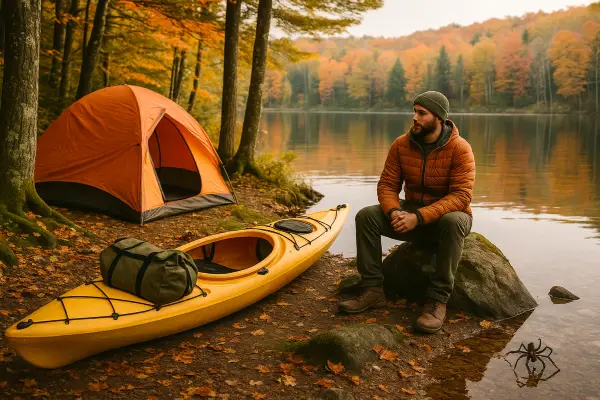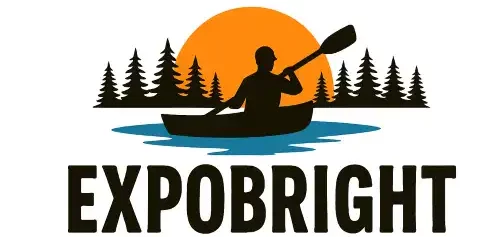Vermont’s waterways offer some of New England’s most spectacular paddle-in camping experiences, but knowing where to find these hidden gems can feel overwhelming for first-time kayak campers. From remote island retreats to pristine mountain reservoirs, the Green Mountain State rewards adventurous paddlers with unforgettable nights under the stars. Where can you kayak camp in Vermont?
During my early guiding days, I learned that Vermont’s best kayak camping spots require more than just throwing gear in a boat and hoping for the best. After countless expeditions across the state’s lakes, reservoirs, and rivers, I’ve discovered that successful kayak camping here demands careful planning, proper gear selection, and understanding of Vermont’s unique paddling regulations.
Where can you kayak camp in Vermont?
Vermont offers exceptional kayak camping opportunities at several state parks and waterways, with over 85 remote paddle-in campsites spread across pristine lakes, reservoirs, and rivers throughout the state. The premier destinations include Green River Reservoir’s 27 remote sites accessible only by paddling, Burton Island’s unique car-free island experience, and Waterbury Reservoir’s 27 backcountry sites scattered along 5 miles of shoreline.

Premier island camping destinations
Burton Island State Park stands as Vermont’s crown jewel of kayak camping, offering a 253-acre car-free island in Lake Champlain’s northern waters. The park features 26 waterfront lean-tos, 14 developed tent sites, and four remote backcountry sites accessible only by boat. Paddlers can either take the 10-minute ferry ride from Kill Kare State Park or paddle the short ¾-mile crossing themselves.
The four remote sites at Burton Island’s southern tip provide true wilderness camping with fire pits, picnic tables, and composting privies, yet no running water. These sites sit just above rocky ledges that drop to pebble beaches, offering perfect kayak storage and incredible sunrise views over Lake Champlain.
Woods Island State Park offers five remote paddle-in sites and welcomes dogs, making it perfect for families wanting to bring their four-legged camping companions. Knight Island provides additional island camping opportunities with day-use facilities and boat rentals.
Mountain reservoir wilderness camping
Green River Reservoir State Park delivers Vermont’s most pristine kayak camping experience, with 27 remote sites scattered around a 653-acre reservoir featuring 19 miles of virtually undeveloped shoreline. All campsites require paddling 1-2 miles from the boat launch, ensuring a true backcountry experience with designated “quiet” lake regulations allowing only electric motors up to 5 mph and human-powered watercraft.
The reservoir features more than 10 islands, some with primitive campsites, and serves as habitat for nesting loons, great blue herons, ospreys, and occasionally bald eagles. Each remote site includes a fire pit and privy, with maximum occupancy determined by individual site characteristics.
Waterbury Reservoir offers 27 remote campsites spread across 5 miles of shoreline, accessible from multiple launch points including Moscow Paddlers’ Access and Waterbury Dam Access. Unlike Green River’s quiet restrictions, Waterbury allows all types of boating, including motorboats and personal watercraft, though the remote sites provide peaceful overnight experiences.
River corridor camping opportunities
The Connecticut River Paddlers’ Trail spans over 400 miles with primitive campsites and river access points from the headwaters to Long Island Sound. While most rivershore remains privately owned, generous landowners host the public at primitive campsites, creating unique multi-day paddling opportunities through Vermont’s Connecticut River Valley.
Wilgus State Park on the Connecticut River serves as an excellent base camp for river paddling adventures, offering developed camping with canoe and kayak rentals, plus easy river access for day trips or longer expeditions. The park, originally built by the Civilian Conservation Corps in the 1930s, remains the only developed state park directly on the Connecticut River in Vermont.
Essential planning considerations
Vermont’s paddle-in camping requires advance reservations at most locations. Burton Island reservations open 11 months in advance on the 15th of each month, with waterfront sites booking extremely quickly. Green River Reservoir operates first-come, first-served for individual sites, though group reservations require calling the park directly.
Both Green River and Waterbury Reservoir have extremely limited parking available on a first-come, first-served basis. Plan to arrive early, especially on weekends and holidays, as full parking areas prevent entry to the parks.
Water sources vary significantly between locations. Green River Reservoir provides no potable water, requiring paddlers to bring their own or filter from the lake. Burton Island’s remote sites also lack running water, though the main campground offers facilities. Always pack more water than you think you’ll need, or bring reliable filtration equipment.
Vermont State Parks prohibit out-of-state firewood unless packaged, labeled as heat-treated, and certified by USDA or appropriate state departments of agriculture. Purchase firewood locally or pack lightweight cooking stoves for reliable meal preparation.
Gear recommendations for Vermont conditions
Vermont’s mountain and lake environments create unique challenges for kayak campers. Pack layers for temperature swings, especially around large water bodies where conditions change rapidly. Waterproof storage remains critical – even calm paddling days can turn choppy quickly.
Choose lightweight, compact camping gear since everything must fit in your kayak’s storage compartments. Prioritize a quality sleeping system rated for nighttime temperatures that often drop 20-30 degrees below daytime highs, even in summer.
Insect protection becomes essential during Vermont’s bug season (late May through August). Pack both repellent and head nets, as mosquitoes and black flies can be intense near water sources and wooded campsites.
Conclusion
Last September, I guided a family of five to Burton Island’s remote site #4, where we watched a spectacular sunset paint the Adirondacks orange and pink while loons called across the darkening water. The parents had initially worried about paddling with young children, but following a solid planning approach transformed their anxiety into pure adventure. Vermont’s kayak camping destinations reward prepared paddlers with experiences that create lifelong memories – the difference between a magical trip and a survival challenge often comes down to choosing the right location, planning thoroughly, and packing smart.
